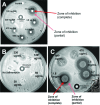In Vitro Characterization of Variable Porosity Wound Dressing With Anti-Scar Properties
- PMID: 29896321
- PMCID: PMC5981800
In Vitro Characterization of Variable Porosity Wound Dressing With Anti-Scar Properties
Abstract
Introduction: New options are needed to improve wound healing while preventing excessive scar formation. Temporary primary dressings are important options in topical wound management that allow the natural healing process. Methods: We evaluated a novel primary dressing consisting of a biosynthetic, variable porosity, matrix-containing gelatin and Aloe Vera extract and a derivative dressing coated with the anti-scarring agent salinomycin for their ability to promote cell growth, reduce myofibroblast formation, and regulate cytokine production. In addition, salinomycin-coated primary dressings were tested for antimicrobial activity. Results: Both primary wound dressings permitted cell growth and attenuated TGFβ-induced scar-forming myofibroblast formation. The primary wound dressings also reduced IL-6 production by 50%, IL-8 by 20%, MCP-1 by 75%, and GRO by 60% in human mesenchymal stem cells treated with TGFβ. Salinomycin coating of the dressing showed antimicrobial activity by preventing Staphylococcus aureus growth. Conclusions: Both primary wound dressings support the growth of human fibroblasts and stem cells, as well as reduce inflammatory cytokine production, demonstrating their potential to serve as temporary wound dressings.
Keywords: antimicrobial; excessive scarring; mesenchymal stem cell; myofibroblast; salinomycin.
Figures





Similar articles
-
Evaluating a Variable Porosity Wound Dressing With Anti-Scar Properties in a Porcine Model of Wound Healing.Eplasty. 2018 May 24;18:e20. eCollection 2018. Eplasty. 2018. PMID: 29896320 Free PMC article.
-
Composite wound dressings of pectin and gelatin with aloe vera and curcumin as bioactive agents.Int J Biol Macromol. 2016 Jan;82:104-13. doi: 10.1016/j.ijbiomac.2015.10.087. Epub 2015 Nov 1. Int J Biol Macromol. 2016. PMID: 26529192
-
Development of novel wound care systems based on nanosilver nanohydrogels of polymethacrylic acid with Aloe vera and curcumin.Mater Sci Eng C Mater Biol Appl. 2016 Jul 1;64:157-166. doi: 10.1016/j.msec.2016.03.069. Epub 2016 Mar 24. Mater Sci Eng C Mater Biol Appl. 2016. PMID: 27127040
-
Smart Dressings Based on Nanostructured Fibers Containing Natural Origin Antimicrobial, Anti-Inflammatory, and Regenerative Compounds.Materials (Basel). 2015 Aug 11;8(8):5154-5193. doi: 10.3390/ma8085154. Materials (Basel). 2015. PMID: 28793497 Free PMC article. Review.
-
Choosing a Wound Dressing Based on Common Wound Characteristics.Adv Wound Care (New Rochelle). 2016 Jan 1;5(1):32-41. doi: 10.1089/wound.2014.0586. Adv Wound Care (New Rochelle). 2016. PMID: 26858913 Free PMC article. Review.
Cited by
-
Salinomycin inhibits proliferative vitreoretinopathy formation in a mouse model.PLoS One. 2020 Dec 21;15(12):e0243626. doi: 10.1371/journal.pone.0243626. eCollection 2020. PLoS One. 2020. PMID: 33347461 Free PMC article.
-
Wound healing with botanicals: A review and future perspectives.Curr Dermatol Rep. 2018 Dec;7(4):287-295. doi: 10.1007/s13671-018-0247-4. Epub 2018 Oct 25. Curr Dermatol Rep. 2018. PMID: 31106027 Free PMC article.
-
Fish and the Thyroid: A Janus Bifrons Relationship Caused by Pollutants and the Omega-3 Polyunsaturated Fatty Acids.Front Endocrinol (Lausanne). 2022 May 27;13:891233. doi: 10.3389/fendo.2022.891233. eCollection 2022. Front Endocrinol (Lausanne). 2022. PMID: 35712237 Free PMC article. Review.
References
-
- Huang JS, Wang YH, Ling TY, Chuang SS, Johnson FE, Huang SS. Synthetic TGF-beta antagonist accelerates wound healing and reduces scarring. FASEB J. 2002;16:1269–70. - PubMed
-
- Dimmeler S, Zeiher AM. Netting insights into fibrosis. N Engl J Med. 2017;376:1475–7. - PubMed
-
- Tan H, Wasiak J, Paul E, Cleland H. Effective use of Biobrane as a temporary wound dressing prior to definitive split-skin graft in the treatment of severe burn: a retrospective analysis. Burns. 2015;41:969–76. - PubMed
LinkOut - more resources
Full Text Sources
Other Literature Sources
Miscellaneous
